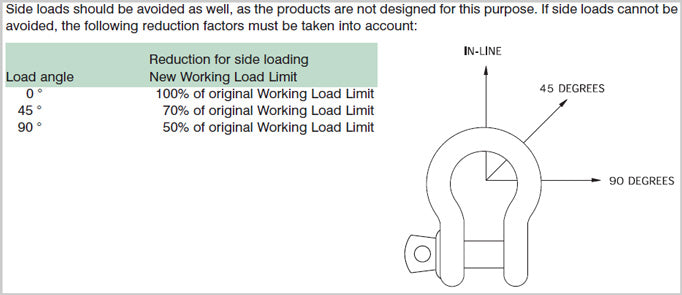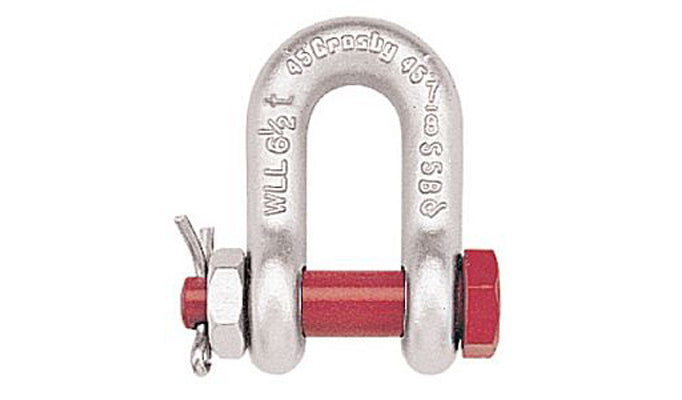You have no items in your shopping cart.
0
You have no items in your shopping cart.
Shackle - A U-shaped piece of metal that is secured by a clevis pin or bolt and nut across the opening.
Shackles are used for all kinds of different applications, from industrial rigging to sailing. Any time an extremely strong and reliable connection point is needed, usually a shackle suits the application best.
We use shackles for slackline rigging all the time, but not all shackles are built the same. Even among the different varieties of shackles there is quite a bit of variation. There are, however, a few characteristics that not all shackles have that are absolutely necessary for our application.
One trait that is necessary for a shackle to have for it to be acceptable for use in slacklining is either a fixed working load limit or known breaking strength. Some shackles are not built to withstand sustained loads and this is very dangerous in slacklining. We typically see loads in the 1,000 - 5,000 lbf range and to have a piece of metal explode with this much energy behind it can be extremely damaging and even fatal. So, for this reason, only use shackles that either have a working load limit stamped on the shackle, or a reliable breaking strength displayed on the retailers website.
Another feature that's absolutely necessary, especially for anchor shackles, is reliability. As I mentioned above, not all types of shackles are made the same. Even shackles that have a stamped working load limit can be unreliable. I went to a local wire-rope shop that has a giant pull testing machine to do some break tests recently and I was talking to the owner of the shop. He said that one time he was testing a batch of 3/4" Anchor Shackles that came from China. These shackles all had a working load limit of 7-tons stamped on the body. He pulled all of these shackles to the point of failure and all of them tested out above the specification except for one. This one shackle broke at a measly 3,000 lbf, or 1/5 of the working load limit, which is supposed to have at least a 5:1 safety ratio! This goes to show that manufacturer errors DO happen and for a piece of gear that we put so much faith into, we need be absolutely sure it is reliable. The only way to do this is to only purchase shackles that are individually tested for strength, or at the very least, batch tested. Companies such as Van Beest, Crosby, and CM test a set percentage of the shackles they produce to be sure the entire batch is reliable and consistent. Other companies, such as Peterson, pull every single one of their shackles to 2x the working load limit to be absolutely sure that it will withstand the loads that they advertise them to. These shackles may cost a few extra dollars, but they are guaranteed to hold the working load limit for as long as they are used.
Last but not least, something that you should pay attention to is how a given shackle is manufactured. There are typically two ways a shackle is made: forging and casting. Forged shackles are made by taking a plate of steel and smashing down on it with a large hammer that has a shape cut out on it; this shape imprints on to the plate of steel. This method ensures that the entire shackle is of the same grade and density of steel. Cast shackles are made by pouring molten metal into a mold and then allowing it to dry. This process allows for air bubbles to form and persist within the finished item, which can severely decrease the breaking strength. For this reason, cast shackles are usually not rated for lifting and typically do not have an advertised breaking strength or working load limit.
With these attributes in mind, let's take a look at the different kinds of shackles.

Often referred to as bow shackles (although, they are NOT the same as the bow shackles below), these are most commonly used for industrial applications. They are typically forged from galvanized steel and the ones made for lifting are stamped with a working load limit (WLL). For each size of shackle, there is usually a standard working load limit (i.e. 1/2" shackles usually have a 2-ton working load limit). However, this is not regulated, so there are some non-standard shackles out there that have higher or lower working load limits than others. Be sure to only use shackles that are rated for lifting and are tested for reliability.
In slacklining, Anchor shackles are great for your anchors. There shape is ideal for situations where there are more than 2 directions of loads (i.e. at the anchor). Because of this, we can use shackles even in situations where we have many many directions of loads, like on a highline anchor with lots of bolts. However, the working load limit on shackles should be reduced by a small amount, depending on the angles the load creates at the shackle (as described in this article: http://www.vanbeest.nl/public/files/catalogue/en/Chapter01_Shackles.pdf).

Anchor shackles are the most common shackles out there. Because of this, their dimensions are pretty standard. It's important to know what the dimensions of your shackle are before purchase because certain applications require certain sized shackles. Please refer to the image below to find the most common dimensions of the popular Anchor Shackle.


Bow shackles are very similar to anchor shackles in their shape, but the actual 'Bow' of the shackle is far bigger than an anchor shackle. These types of shackles are most commonly made of stainless steel or titanium and are very nicely suited for slacklining due to their geometry. The 1/2" (12mm) size usually has a 1" width at the mouth, which makes it perfect for a webbing anchor.
Be careful with Bow Shackles though, as they are the most common shackle that is made from cast stainless steel. Be sure to look for the forged variations of them for the highest reliability.
Because bow shackles are so common, the dimensions are fairly consistent. Here is a chart that shows the dimensions of some common sized bow shackles:


Chain shackles, also referred to as Dee Shackles, are straight-legged shackles that are typically used in bi-directional load situations. Their shape is optimized for two directions of pull, which makes them great for connecting pieces of gear together (such as your pulleys to the rigging plate, or your rope to the becket of your pulleys). These types of shackles are not good for situations where there are more than two directions of loads because of their geometry. The angled loads place a great deal of stress on the bolt-side of the shackle and can cause premature failure.
Be careful when purchasing Chain Shackles. Although they are often referred to as Dee Shackles, they are not always the same as Dee Shackles. The geometry of the two is slightly different and they are often made from different materials. Here are images of the dimensions of both types of shackles:



Twist shackles are very similar to Dee Shackles, but they are twisted 90-degrees. These are great for when you need to rotate gear and you don't want to use two connectors. Although, it's hard to find twist shackles that are large enough to hold the full force of your line, the small ones are great for connecting components together in your pulley system (i.e. for rotating your brake 90-degrees so that the handle is facing downwards).

There are hundreds of other types of shackles out there and they all serve a purpose. The shackles above are the most commonly used in rigging and slackline applications.
| Product | Price | Quantity | Options | |||||
|---|---|---|---|---|---|---|---|---|
| Features |
| Availability: |
| Price |
| Options |
| Actions |

← Older Post Newer Post →
0 comments